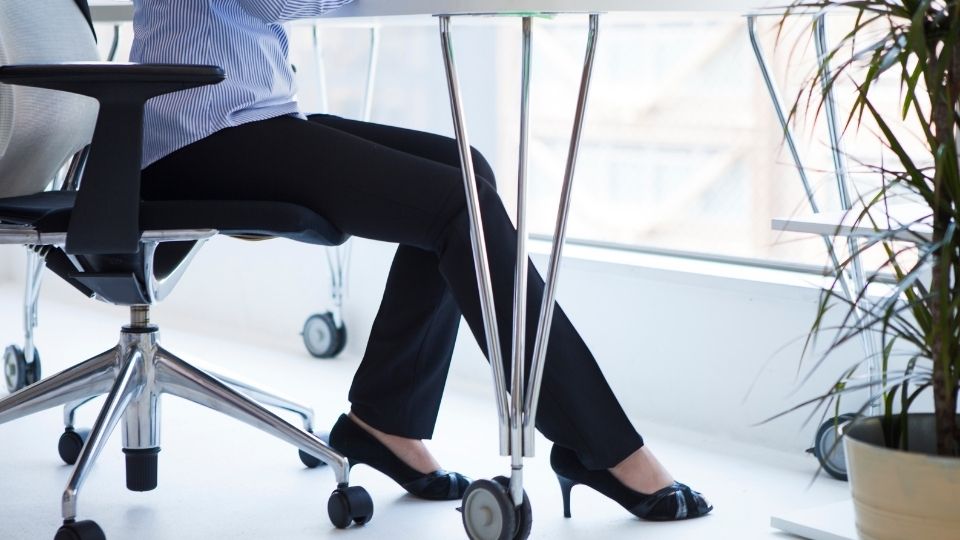How High Should Your Desk Be?
Do you have trouble finding a comfortable height for your desk chair? You’re not alone. A recent study found that almost half of all workers don’t have their desks at the right height. But what is the right height, and how do you find it? Read on to learn more.
As a general rule, the standard height of a seated office desk is 72-80 cm (28-32 in) and 100-117 cm (40-46 in) for standing desks. Your standing desk should be at about elbow height. This means your elbows should be in a 90-degree position from the floor.
There is no shortage of articles on what height your desk height should be out there. However, if you are looking for some straightforward advice on how to deal with chronic pain and feel great at work from a chiropractor who spent over 30 years helping people just like you, then this article is for you!
Here’s why I can help:
- I’ve been practicing chiropractic for almost 30 years
- also trained as an ergonomist.
- published book on posture
- spoke on this subject on national tv,
- designed an orthopedic mattress and neck pain pillow
- ran a successful Kickstarter campaign on posture correcting devices
When your work environment doesn’t live up to its potential because of poor design decisions like not having your desk at the right height, you’re bound to feel anything from frustrating discomfort down to outright fatigue daily.
These conditions may appear insignificant or even incomprehensible, but they are telling you that something has gone wrong with your workspace, not just how safe it feels, but also how effective you will be working there day after day without interruption.
Many employees struggle with finding their “perfect spot” within their workspace, so they feel either uncomfortable or out of place-but, this doesn’t have to be the case! The perfect solution is a built-in desk that can fit any individual’s needs.
Let me show you how to set up your proper desktop height so that you are comfortable and avoid any potential back pain while sitting or standing. I’ll then give some simple and straightforward solutions for those of us who can’t seem to find the time!
5 Important Factors For Proper Desk Height
Standing desks and sit-to-stand desk risers are not always ergonomic for most people. There are two categories of users that the majority missed, shorter or very tall ones. To avoid any potential problems, be sure to consider height when choosing a standing workstation solution:
Typing Position
Make sure to keep your elbows at a 90-degree angle when typing, whether you are sitting or standing. This is the most relaxed way to type and will eliminate hunching over too much. If you have hands that are resting low on the keyboard, then it means that they may be extending your wrists which can put stress on tendons/ligaments in this area if not corrected soon enough. If your hands happen to rest high up, make sure their elbow isn’t bending backwards as this could lead to an uncomfortable position of your neck.
Eye Height
When you are sitting, your eyes should line up with your monitor’s top two to three inches. If not, it could cause neck and back problems. In a standing position, be mindful about how far down your chin goes during work time – every inch farther from that point means 10 pounds more pressure on the spine’s discs and ligaments, as well as an increased risk for carpal tunnel syndrome.
Feet Positioning
When you’re sitting at your desk, it’s essential to ensure that both the chair and computer table are adjustable. It might seem like a simple detail, but if the height of these items isn’t correct for a person, they can experience back or joint pain in just minutes. The most common complaint is often foot fatigue due to dangling one over another while working on their laptop, which isn’t comfortable nor healthy! There should be enough room so that when feet touch down flatly against the floor. Also, try to keep your feet at least shoulder-width apart. A wider foot position stabilises and helps you move better.
Sitting Posture

An ideal seat height minimises adverse effects on thighs, shoulders and neck while working. That’s why ergonomic guidelines for sitting in offices are essential.
- Make sure your two feet touch the floor completely, and your knees are directly above or in front of your feet by adjusting the seat height lever. Seats that are too low can create pressure points since they decrease the surface area of the seat. Seats that are too high can cause problems with circulation.
- You should have your feet directly under or ahead of your knees.
- While using a computer, your elbows should be at a 90-degree angle at the side of your trunk, with your forearms 2-3 cm above the desk.
- With your back firmly against the backrest of your seat, the backrest of your seat should have a 5cm gap between the edge of your leg and the edge of the seat pan.
- Seats should tilt forward. The best angle is 110 degrees. As such, your hips should be 8-10cm higher than your knees. If your chair doesn’t tilt forward, sit on a seat wedge with the thicker part toward the chair’s back.
Work Surface
Steady Work surfaces are essential to reduce the risk of injury, particularly when holding multiple monitors. Many workers had found that a sit-stand desk wouldn’t work when they leant on the edge and discover its contents falling off. It is advisable to speak to a professional before purchasing a standing desk to ensure the surface is large and robust enough to hold your equipment and you leaning on it. It is ideal to have a closer look at a product in person to get advice from an expert.
Problems & Solutions Caused By Improper Desk Height
Looking Down Laptop Screen
Most people use their laptops by placing them on their desks or laps. This is fine for a short time, but any longer, and your neck and shoulders will feel it. If you place a laptop on your lap, the force exerted on your neck is three times as great as it is with a straight neck when using a laptop.
One study found that “As the head tilts forward the forces seen by the neck surges to 27 pounds (12kg) at 15 degrees, 40 pounds (18kg) at 30 degrees, 49 pounds (22kg) at 45 degrees and 60 pounds (27kg) at 60 degrees,”. This researcher developed a cervical spine model to calculate the forces experienced by the cervical spine when it is in incremental flexion (forward head position). According to the math that he used, the weight on the spine increases dramatically when flexing the head forward.
The motion of looking down might seem harmless, but it can lead to neck pain, upper back spinal muscle strain, and even damage the spine for long periods. This strain is dangerous to our health, considering people spend upwards of 4 to 10 hours a day in this position.
Solution
You don’t have to strain your neck or lean forward awkwardly when you’re working on a laptop, to get the proper desk height, just elevate the screen and then sit back in a more comfortable position. You might not think it makes much of a difference whether you work with an elevated monitor but try placing one at eye level for 10 minutes and see how that feels- any discomfort should be pretty straightforward!
Wrong Monitor Placement
Put an incorrectly placed monitor too low or too high, and you’ll constantly be craning your neck to see the screen. If you use two monitors, the placement will cause you to switch your neck to see the screen frequently. Both actions will cause neck pain over time.
The neck and shoulders are already under intense strain when you bend them downward. What’s wrong with frequently turning your head from one monitor to another?
Studies show that twisting the neck often to use dual monitors can cause neck pain and other neck-related structural disorders.
Solution
Make sure you’re using your monitors at the proper height, distance, and angle. For this issue, the answer depends on the following: Whether you’re using one monitor or two monitors.
Single Monitor Setup
An optimal way to set up a single monitor is to avoid eye or neck strain. The screen should be at arm’s length, but not too close to ruin your eyesight; and it should not be so far away that you have to strain to read the first line of a document. If glasses aren’t worn then one must accommodate your eyes by viewing an object with black letters 1-2 inches from them when looking straight ahead for both sets of lenses to focus correctly within seconds.
Multiple Monitor Setup
When placing two or more monitors together, the guidelines for distance and height are similar to a single monitor set up. The key difference is how they should be positioned.
If you plan on using the two monitors equally, be sure to position them so they are a semicircle around you, so their outer edges are right up against each other, with their apex directly behind you.
If one monitor is used more, place your primary directly in front of you. The secondary should be placed in front and to the right, with its inner edges touching those of your first screen. This will create a much more immersive experience for you as well!
Conclusion
So, is it time to ditch the chair and invest in a standing desk? Studies show that there are many benefits to working at a standing desk. Not only can you burn up to 50% more calories, but you’ll also improve your cardiovascular health, increase your productivity, and reduce your risk of obesity, heart disease, and cancer. If you’re not sure where to start or how to make the switch from sitting to standing, we can help. Our team of experts will work with you to find the perfect standing desk for your needs and show you how to set it up so that you can start reaping the rewards of a healthy workplace today. Have you made the switch to a standing desk? What tips














